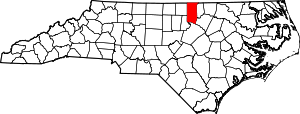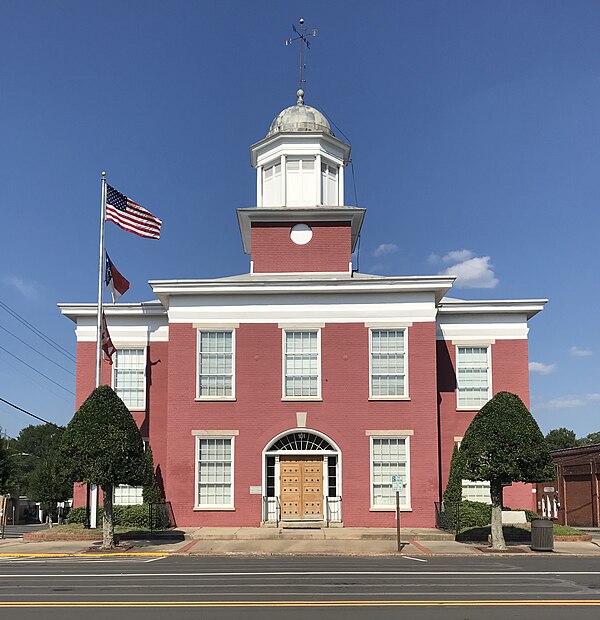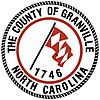Granville County, North Carolina
County in North Carolina, United States From Wikipedia, the free encyclopedia
Granville County is a county located on the northern border of the U.S. state of North Carolina. As of the 2020 census, the population was 60,992.[1] Its county seat is Oxford.[2] The county has access to Kerr Lake and Falls Lake and is part of the Roanoke, Tar and Neuse River watersheds.
Granville County | |
|---|---|
 | |
 Location within the U.S. state of North Carolina | |
 North Carolina's location within the U.S. | |
| Coordinates: 36.30°N 78.66°W | |
| Country | United States |
| State | North Carolina |
| Established | June 28, 1746 |
| Named for | John Carteret, 2nd Earl Granville |
| Seat | Oxford |
| Largest community | Oxford |
| Area | |
• Total | 537.59 sq mi (1,392.4 km2) |
| • Land | 531.99 sq mi (1,377.8 km2) |
| • Water | 5.60 sq mi (14.5 km2) 1.04% |
| Population (2020) | |
• Total | 60,992 |
• Estimate (2023) | 62,192 |
| • Density | 110/sq mi (44/km2) |
| Congressional districts | 1st, 13th |
| Website | granvillecounty |
History
Summarize
Perspective
18th century
Granville County and St. John's Parish were established on June 28, 1746, from the upper part of Edgecombe County.[3] It was named for the John Carteret, 2nd Earl Granville,[4] who as heir to one of the eight original Lords Proprietors of the Province of Carolina, claimed one eighth of the land granted in the charter of 1665. The claim was established as consisting of approximately the northern half of North Carolina, and this territory came to be known as the Granville District, also known as Oxford.
In 1752, parts of Granville, Bladen, and Johnston counties were combined to form Orange County. In 1764, the eastern part of Granville County was reassigned to the new Bute County. Finally, in 1881, parts of Granville, Franklin, and Warren counties were taken to be combined as Vance County.
Like most early counties on the eastern side of the early North Carolina colony, Granville was site of the Tuscarora uprising. Once the natives were defeated in the Tuscarora War, Virginia farmers and their families settled Granville County, where they concentrated on tobacco as a commodity crop. The economy of the region was dependent on slave labor, as tobacco was very labor-intensive to cultivate and process. By the start of the Civil War, Granville planters worked more than 10,000 slaves on their farms, at a time when total county population was 23,396.
19th century
During the American Civil War, more than 2,000 men from Granville County served the Confederacy. One company was known as the "Granville Grays." Most of these men fought in the major battles of the war. Surprisingly, many survived until the end of the war. Although the war brought an end to the plantation and slave labor economy that had made Granville County prosperous, the agricultural sector continued to thrive in the county. Freedmen stayed in Oxford to work, and the discovery of bright leaf tobacco stimulated the industry. Many African Americans in Granville County were already free before the start of the war; some had migrated into North Carolina as free people from Virginia in the colonial era. The free people of color before the Civil War were often descendants of families formed by unions between white women (who were free) and African or African-American men before the American Revolution.[5] They made lasting contributions to the region, particularly through their skilled labor. Several black masons constructed homes for the county's wealthy landowners. Additionally, the bright leaf tobacco crop proved a successful agricultural product for Granville County. The sandy soil and a new tobacco crop that could be "flue-dried" proved a great incentive to farmers and tobacco manufacturers.
According to historian William S. Powell, Granville has remained a top tobacco-producing county in North Carolina for several decades. By the late 1800s and early 1900s, Oxford had become a thriving town with new industries, schools, literary institutions, and orphanages, due to jobs created by the bright tobacco crop.
In the late 1800s and early 1900s, northern Granville County, together with Halifax County, Virginia, were important mining areas. Copper, tungsten, silver and gold were mined in the region. The Richmond to Danville Railroad was a critical lifeline to the northern part of the county and provided an important link for miners and farmers to get their goods to larger markets in Richmond and Washington, D.C.
From the late 19th century into the early 20th century, whites in Granville County lynched six African Americans, a number of extralegal murders equalled by two other counties in the state. Most of these killings took place in the decades around the turn of the century. Each of the three counties is tied in having the second-highest number of lynchings per county.[6] Among these was a double lynching in the county seat on December 1, 1881. An armed mob of masked men stormed into the county jail, forcing the jailer to give them the keys. They took out John Brodie and Shadrack Hester, two African-American men charged with murdering a local white man. They took the prisoners to a tree near where the death took place, and hanged them.[7]

During the late 1800s and early 1900s, Granville County played a pivotal role as tobacco supplier for the southeast United States. With many farms and contracts tied to major tobacco companies, such as American Tobacco Company, Lorillard, Brown & Williamson, and Liggett Group, the local farmers became prosperous. During the Great Depression, the tobacco fields were subject to a new plant disease. The Granville Wilt Disease, as it became known, destroyed tobacco crops all across northern North Carolina. Botanists and horticulturists found a cure for the disease at the Tobacco Research Center located in Oxford.
20th century
In August 1941, the U.S. federal government beginning planning for the development of a military facility in southern Granville County, motivated partly by its proximity to a rail line. Following the United States' entry into World War II that December, planning hastened and in January 1942 the government began ordered locals to vacate their land. The government ultimately evicted between 400 to 500 families and razed most of their homes and agricultural buildings to make way for a U.S. Army camp. Construction commenced in March and Camp Butner officially opened in August 1942. Thousands of soldiers were trained at the camp for service overseas, and it also housed a prisoner of war facility. By April 1946, activity at the facility had declined significantly and it was officially closed in January 1947.[8] Following the camp's closure, its land was divided up among the U.S. War Assets Administration, the North Carolina National Guard, the state of North Carolina, and the dispossessed farmers who had once lived in the area.[9] The state converted its former infirmary into a psychiatry hospital. A civilian community, Butner, subsequently developed around the hospital's new workforce.[8]
In the 1950s and 1960s, various manufacturing businesses built up across Granville County, and the region gradually became more industrialized. Today, the manufacturing industry produces cosmetics, tires, and clothing products in Granville County.
Geography
According to the U.S. Census Bureau, the county has a total area of 537.59 square miles (1,392.4 km2), of which 531.99 square miles (1,377.8 km2) is land and 5.60 square miles (14.5 km2) (1.04%) is water.[10]
State and local protected areas
- Butner-Falls of Neuse Game Land (part)[11]
- Ledge Creek Forest Conservation Area
- Roberts Chapel Conservation Area
Major water bodies
- Beaver Dam Lake
- Beaverdam Creek
- Coon Creek
- Falls Lake
- Fishing Creek
- Island Creek Reservoir
- John H. Kerr Reservoir
- Lake Butner
- Lake Devin
- Roanoke River
- Smith Creek
- Tar River
Adjacent counties
- Halifax County, Virginia – north
- Mecklenburg County, Virginia – north
- Vance County – east
- Franklin County – east
- Wake County – south
- Durham County – southwest
- Person County – west
Major highways
Major infrastructure
Demographics
Summarize
Perspective
| Census | Pop. | Note | %± |
|---|---|---|---|
| 1790 | 10,982 | — | |
| 1800 | 14,015 | 27.6% | |
| 1810 | 15,576 | 11.1% | |
| 1820 | 18,222 | 17.0% | |
| 1830 | 19,355 | 6.2% | |
| 1840 | 18,817 | −2.8% | |
| 1850 | 21,249 | 12.9% | |
| 1860 | 23,396 | 10.1% | |
| 1870 | 24,831 | 6.1% | |
| 1880 | 31,286 | 26.0% | |
| 1890 | 24,484 | −21.7% | |
| 1900 | 23,263 | −5.0% | |
| 1910 | 25,102 | 7.9% | |
| 1920 | 26,846 | 6.9% | |
| 1930 | 28,723 | 7.0% | |
| 1940 | 29,344 | 2.2% | |
| 1950 | 31,793 | 8.3% | |
| 1960 | 33,110 | 4.1% | |
| 1970 | 32,762 | −1.1% | |
| 1980 | 34,043 | 3.9% | |
| 1990 | 38,345 | 12.6% | |
| 2000 | 48,498 | 26.5% | |
| 2010 | 57,538 | 18.6% | |
| 2020 | 60,992 | 6.0% | |
| 2023 (est.) | 62,192 | [1] | 2.0% |
| U.S. Decennial Census[12] 1790–1960[13] 1900–1990[14] 1990–2000[15] 2010[16] 2020[1] | |||
2020 census
| Race | Number | Percentage |
|---|---|---|
| White (non-Hispanic) | 33,610 | 55.11% |
| Black or African American (non-Hispanic) | 18,315 | 30.03% |
| Native American | 205 | 0.34% |
| Asian | 366 | 0.6% |
| Pacific Islander | 24 | 0.04% |
| Other/Mixed | 2,261 | 3.71% |
| Hispanic or Latino | 6,211 | 10.18% |
As of the 2020 census, there were 60,992 people, 21,400 households, and 15,182 families residing in the county.
2017 census estimate
At the 2017 census estimate,[18] there were 59,557 people in 20,628 households residing in the county. The population density was 111.6 people per square mile (43.1 people/km2). There were 22,827 housing units at an average density of 42.5 units per square mile (16.4 units/km2). The racial makeup of the county was 58% White, 30% Black, 8% Hispanic, 2% Two or more Races, 1% Asian, 1% American Indian.
There were 20,628 households, out of which 31.0% had children under the age of 18 living with them. The average household size was 2.90. In the county, the population was spread out, with 22.3% under the age of 18, 8.5% from 18 to 24, 12.0% from 25 to 34, 24.1% from 35 to 49, 20.7% from 50 to 64, and 12.40% who were 65 years of age or older. For every 100 females there were 114.7 males.
The median income[19] for a household in the county was $48,196, and the mean household income was $55,849. The median and mean income for a family was $56,493 and $64,311, respectively. The per capita income for the county was $21,201. About 7.6% of families and 11.9% of the population were below the poverty line, including 14.4% of those under age 18 and 11.1% of those age 65 or over.
Law and government
Summarize
Perspective
Granville County is a member of the Kerr-Tar Regional Council of Governments.[20] Granville County is governed by a commissioner/manager form of government under the laws of the state of North Carolina. Granville County has seven commissioner electoral districts.
The Granville County Commissioners are Timothy Karan(chair), Jimmy Gooch(Vice-chair), Zelodis Jay, Rob Williford, Sue Hinman, Tony Cozart and Russ May.[21]
Politics
Granville County was long a Democratic stronghold, for the most part, if not exclusively, only supporting Democratic candidates in presidential election until 1968, when it supported George Wallace. Today, it is somewhat of a national bellwether, having from 1992 onward supported the national winner in all the presidential elections with the exception of 2000, when it supported Al Gore, and 2020, when it supported Donald Trump.
| Year | Republican | Democratic | Third party(ies) | |||
|---|---|---|---|---|---|---|
| No. | % | No. | % | No. | % | |
| 2024 | 17,383 | 54.15% | 14,365 | 44.75% | 356 | 1.11% |
| 2020 | 16,647 | 52.68% | 14,565 | 46.09% | 386 | 1.22% |
| 2016 | 13,591 | 49.69% | 12,909 | 47.19% | 853 | 3.12% |
| 2012 | 12,405 | 47.21% | 13,598 | 51.75% | 272 | 1.04% |
| 2008 | 11,447 | 46.30% | 13,074 | 52.88% | 204 | 0.83% |
| 2004 | 9,491 | 51.02% | 9,057 | 48.69% | 53 | 0.28% |
| 2000 | 7,364 | 48.47% | 7,733 | 50.90% | 97 | 0.64% |
| 1996 | 5,498 | 42.95% | 6,747 | 52.71% | 555 | 4.34% |
| 1992 | 4,538 | 37.42% | 6,178 | 50.94% | 1,412 | 11.64% |
| 1988 | 4,880 | 46.75% | 5,280 | 50.58% | 279 | 2.67% |
| 1984 | 6,302 | 54.42% | 5,217 | 45.05% | 61 | 0.53% |
| 1980 | 3,513 | 37.99% | 5,556 | 60.09% | 177 | 1.91% |
| 1976 | 2,955 | 35.84% | 5,244 | 63.59% | 47 | 0.57% |
| 1972 | 6,037 | 66.82% | 2,918 | 32.30% | 80 | 0.89% |
| 1968 | 1,837 | 21.50% | 2,638 | 30.87% | 4,071 | 47.64% |
| 1964 | 2,624 | 36.34% | 4,596 | 63.66% | 0 | 0.00% |
| 1960 | 1,798 | 26.66% | 4,945 | 73.34% | 0 | 0.00% |
| 1956 | 1,463 | 26.72% | 4,013 | 73.28% | 0 | 0.00% |
| 1952 | 1,166 | 20.28% | 4,583 | 79.72% | 0 | 0.00% |
| 1948 | 334 | 8.10% | 3,513 | 85.25% | 274 | 6.65% |
| 1944 | 325 | 9.18% | 3,215 | 90.82% | 0 | 0.00% |
| 1940 | 213 | 5.15% | 3,924 | 94.85% | 0 | 0.00% |
| 1936 | 185 | 4.14% | 4,279 | 95.86% | 0 | 0.00% |
| 1932 | 212 | 5.26% | 3,808 | 94.51% | 9 | 0.22% |
| 1928 | 858 | 22.46% | 2,962 | 77.54% | 0 | 0.00% |
| 1924 | 461 | 17.11% | 2,220 | 82.37% | 14 | 0.52% |
| 1920 | 833 | 24.11% | 2,622 | 75.89% | 0 | 0.00% |
| 1916 | 648 | 27.45% | 1,713 | 72.55% | 0 | 0.00% |
| 1912 | 192 | 9.16% | 1,561 | 74.48% | 343 | 16.36% |
Granville County Courthouse
The Granville County Courthouse, of Greek Revival architecture,[23] was built in 1840[24] and added to the National Register of Historic Places in 1979.
Economy
In its 2025 county economic tier ratings, the North Carolina Department of Commerce classified Granville as among the state's 20 least economically distressed counties, or "tier 1".[25][26]
Education
The Granville County School System contains 9 elementary schools, 4 middle schools, 5 high schools
High Schools
- J.F. Webb High School (Oxford)
- J.F. Webb School of Health and Life Sciences
- Granville Central High School (Stem)
- Granville Early College High (affiliated with Vance-Granville Community College, which has a campus in Butner) (Creedmoor)
- South Granville High School (Creedmoor)
Middle Schools
- Butner-Stem Middle (Butner) (traditional and year round)
- G.C. Hawley Middle (Creedmoor)
- Mary Potter Middle (Oxford)
- Northern Granville Middle (Oxford) (traditional and year round)
Elementary Schools
- Butner-Stem Elementary (Butner) (traditional and year round)
- C.G. Credle Elementary (Oxford)
- Creedmoor Elementary (Creedmoor)
- Mt. Energy Elementary (Creedmoor)
- Stovall-Shaw Elementary (Stovall)
- Tar River Elementary (Franklinton)
- West Oxford Elementary (Oxford) (traditional and year round)
- Wilton Elementary (Franklinton)
Communities

Cities
Towns
Townships
- Brassfield
- Dutchville
- Fishing Creek
- Oak Hill
- Oxford
- Salem
- Sassafras Fork
- Tally Ho
- Walnut Grove
Unincorporated communities
Notable people
- Joseph Penn Breedlove, Duke University librarian 1898-1946
- Tiny Broadwick, first female parachutist
- Benjamin Chavis, Civil Rights leader
- Franklin Wills Hancock Jr., former representative for North Carolina's 5th congressional district
- Richard H. Moore, politician and former North Carolina State Treasurer
- John Penn, signer of the Declaration of Independence
- Sam Ragan, journalist
- Thad Stem Jr., poet
- James E. Webb, NASA administrator and namesake of the James Webb Space Telescope
See also
References
External links
Wikiwand - on
Seamless Wikipedia browsing. On steroids.



